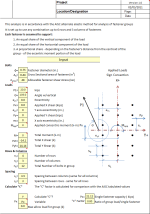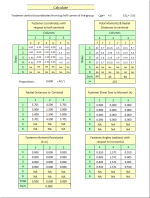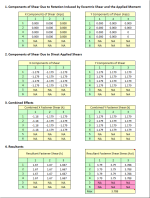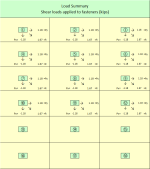Bolt Group Shear Calculation

Description
This calculation is designed to compute the shears in a fastener group subjected solely to direct shear and/or in-plane moments. It employs the elastic analysis method, which, while less precise than the ultimate strength (instantaneous center of rotation) method used in the AISC tables, offers a conservative and simplified approach to designing such connections. This calculation allows for some flexibility beyond the provisions and limitations of the AISC tables:
- The AISC tables do not account for the application of a concentric moment on the group without an accompanying direct shear.
- The AISC tables do not permit the application of load on the group at an arbitrary angle.
- The AISC tables do not allow for the application of more than one shear and/or moment load at a time.
- Fastener spacings in the AISC tables are limited to tabulated values.
- The AISC tables are based on the load-deformation characteristics of A325 bolts. If other types of fasteners are used, the 'C' factors will differ from those tabulated. As the load deformation characteristics for different types of fasteners are generally unknown, this elastic method offers a reliable and conservative way to evaluate loads on the fastener group for bearing type connections.
Additional Advantages:
- The calculation provides a useful vector view of the loads at each bolt. It numerically displays the individual components of shear and their resultants at each bolt, along with their corresponding direction.
- This method can also be used to determine loads for the design of fasteners other than high-strength bolts in steel, as well as for anchor bolts, etc.
User Notes:
- The fastener group size is limited to 3x6.
- The worksheet provides a method for comparing a theoretical 'C' value with the 'C' values tabulated in the AISC bolt group tables.
- The worksheet is protected, but does not require a password.
Calculation Reference
AISC
Structural Steelwork
Steel Designers Manual
To compute the shear forces in a fastener group subject to direct shear and/or in-plane moments using the AISC elastic analysis method, you can follow these steps:
-
Identify the fastener group: Determine the configuration and arrangement of the fastener group, such as bolted connections, welds, or rivets. Note the number and spacing of the fasteners.
-
Determine the applied loads: Identify the direct shear force and/or in-plane moments acting on the fastener group. Ensure you have accurate values for these loads.
-
Calculate the centroid of the fastener group: Determine the centroid of the fastener group. For symmetrical arrangements, the centroid can be easily calculated. However, for irregular configurations, you may need to consider the individual fastener locations and their contributions to the centroid.
-
Calculate the eccentricity: Determine the eccentricity between the applied loads and the centroid of the fastener group. The eccentricity is the distance between the applied loads' line of action and the centroid. Calculate the eccentricity in both the X and Y directions.
-
Calculate the bolt forces: Use the principle of moments to calculate the bolt forces. Apply the equations for equilibrium in the X and Y directions to determine the forces in each bolt. The bolt forces will be a combination of shear forces and moments.
-
Check bolt capacity: Compare the calculated bolt forces to the capacity of the fasteners. Ensure that the fasteners' shear strength and bearing strength are sufficient to resist the calculated forces. Consider factors such as the fastener material, size, and grade when checking the capacity.
It's important to note that the AISC elastic analysis method assumes linear elastic behavior and neglects factors such as fastener deformation, joint stiffness, and load redistribution.
Calculation Preview
Full download access to any calculation is available to users with a paid or awarded subscription (XLC Pro).
Subscriptions are free to contributors to the site, alternatively they can be purchased.
Click here for information on subscriptions.





